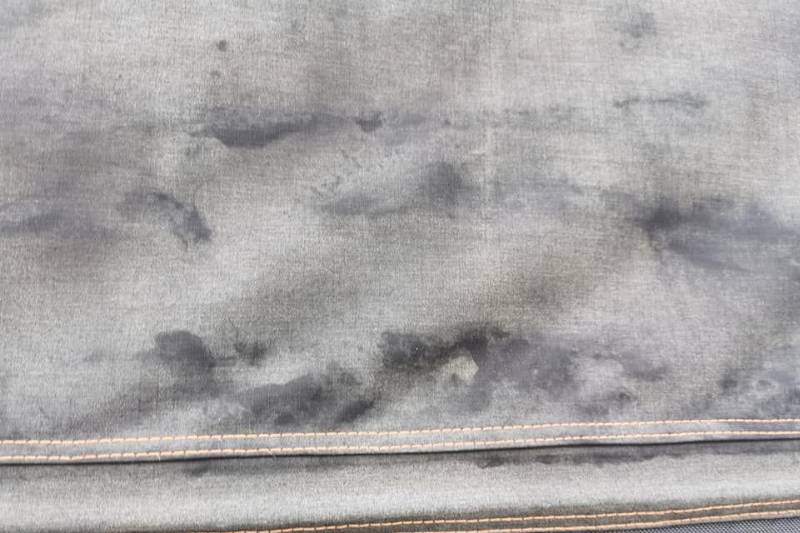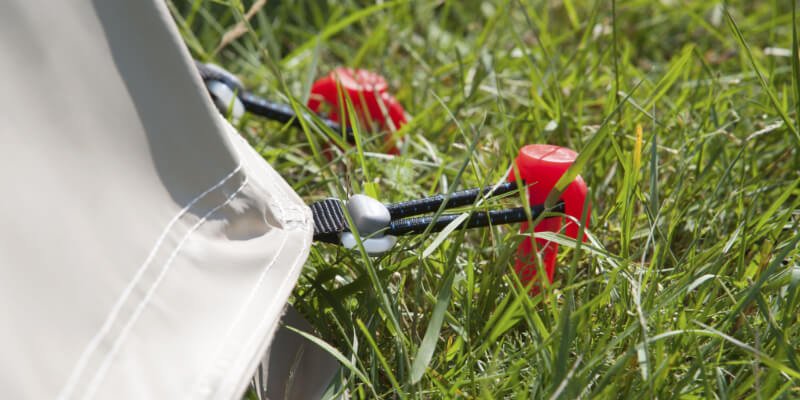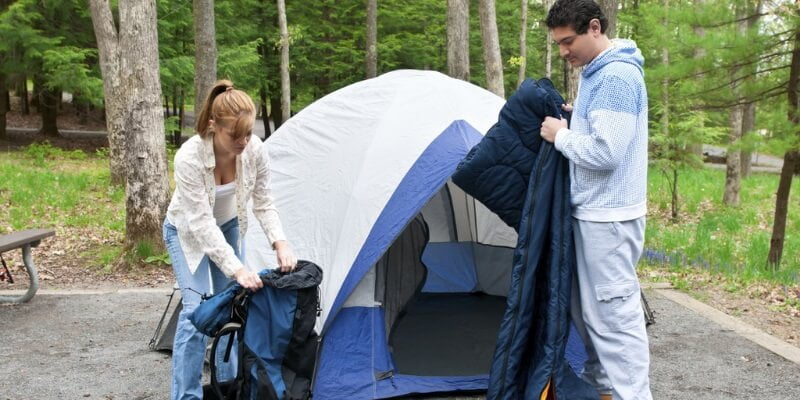What is a Good Waterproof Rating for Tents?

1,500 mm, 3,000 mm, 10,000 mm: if you want to buy a new camping or hiking tent, you will find these numbers everywhere. No wonder: It’s about the water column of the tent. But what does it say? What is good? What bad? How much water column does your new camping or hiking tent should have?
The water column rating indicates a tent’s water resistance, showing how much water pressure it can handle before leakage occurs. For beginners, terms like 1,000 mm, 5,000 mm, or 10,000 mm may seem confusing, but this guide will clarify what these measurements mean and help you understand what qualifies as a good waterproof rating for tents.
How is the Water Column Measured?
The unit of measurement for the water column in a tent is the millimeter (mm). It is all about how many millimeters of water the tent fabric can withstand until it lets the water through. However, the measurement of the water column is therefore quite simple. The manufacturers fill a measuring cylinder with water under which 10 cm³ of tent fabric is stretched.
The manufacturers start with 100 ml in the cylinder. This amount is increased by another 100 ml every minute. If the first three Drops appear on the inside of the fabric, the limit (= water column) has been reached. So it’s more about the pressure that the water needs to penetrate the fabric.
The manufacturers specify this pressure in mm instead of a bar. After all, the simple rule of thumb applies here: the more, the better. Because when it rains you want to stay dry in your tent. Or not?
What is a Good Waterproof Rating for Tents?

But from what value is a water column good? What does 3,000 mm mean? Good? Bad? These categories help…
1,500 mm water column
A 1,500 mm water column rating is the worldwide minimum standard for tents, indicating basic waterproofing. However, hiking tents with this rating are not suited for continuous rain, as prolonged rainfall can exceed 1,500 mm in water pressure, potentially causing leakage.
2,000 mm water column
A 2,000 mm water column rating offers more protection than 1,500 mm, though it’s still not the highest level. This rating is generally sufficient for short hikes or treks during the summer in regions like Central Europe or North America. However, continuous rain could still pose a challenge, so check the forecast before setting out.
3,000 mm water column
A water column rating of 3,000 mm is even better, providing solid protection for longer trips without concern. With this level of waterproofing, you can confidently face unexpected showers.
5,000 mm water column
5,000 mm or more is considered premium, offering superior waterproofing even in extreme weather. Whether venturing to the far north or trekking through rainy regions, this rating ensures your tent stays dry with minimal hassle. However, this level of protection comes at a higher cost, reflecting its quality and durability.
To ensure safety while camping or hiking, look for a tent with a water column of at least 3,000 mm. Ratings of 5,000 mm and above are typically reserved for extreme conditions in the far north or particularly rainy areas. You might even come across tents with a 10,000 mm rating, but unless you’re planning an expedition to the North or South Pole, such high ratings are unnecessary. A 3,000 mm rating provides both flexibility and security. It’s worth noting that anything above 1,300 mm is classified as waterproof, which is why manufacturers often advertise their tents as “absolutely waterproof” with a minimum rating of 1,500 mm. However, Mother Nature doesn’t always adhere to these standards. In practice, conditions can vary significantly from what theory suggests. Here are a few more numbers about the water column: Do you notice something? Keyword tent fabric and tent floor? Why is there a difference here? Quite simply: there is significantly more pressure on the tent floor. Because you lie, sit or kneel on it. Therefore, the tent floor must have a higher water column than the tent’s fabric. When lying, sitting, or kneeling, your body weight creates more pressure and stress. The demands on the tent floor are thus higher than on the tent fabric. For example, If a water column of 3,000 mm is considered a good value for the tent fabric, it is 5,000 mm for the tent floor. Ultimately, the values are somewhat relative. This is because there is no standardized method for measuring the water column. European brands like Bergans, Cocoon, Grand Canyon, Hilleberg, and Jack Wolfskin test their tents when they are brand new. In contrast, American brands such as Big Agnes, Coleman, GoLite, Marmot, Mountain Hardwear, and MSR often measure the waterproofing of tents that are five years old. Logically, a five-year-old trekking tent had to take a lot. The material is subject to aging, plus the influences of the environment, weather, and use. Consequently, the value of a five-year-old product cannot keep up with that of new goods. Accordingly, a water column of 3,000 mm according to the US value is significantly better than the Euro standard. But the comparison lags, because of the US standards, even well-known manufacturers such as MSR often only have a low water column. The MSR Hubba NX or the MSR Elixir 3 only measures 1,200 mm or 1,500 mm for the tent fabric and 3,000 mm for the tent floor. That sounds bad at first. But curious: The Hubba and the Elixir are not cheap tents. With prices around $385 and $250, these tents fall into the mid-range category. European manufacturers often achieve water column ratings of 3,000 to 5,000 mm for their tent fabrics with relative ease. However, due to the differing testing methods and intended uses, this does not necessarily indicate that European tents are of higher quality than their U.S. counterparts. The weak points in a tent’s waterproofing often lie in the seams and zippers. A water column rating of 10,000 mm is meaningless if these critical areas—like seams, corners, and zippers—are not well-constructed. Quality craftsmanship is essential; poorly made seams can lead to water intrusion, resulting in a wet and uncomfortable experience. Therefore, besides the value for the water column, pay attention to: If seams and zippers are poorly made, water ingress is not surprising—it’s a logical outcome. Therefore, seams must be properly taped and treated to enhance waterproofing. Modern trekking or camping tents are made of polyester, nylon, ripstop nylon, cotton, or polycotton (mixed fabric). Polyester is tear and abrasion-resistant, cheap, and waterproof. For this reason, polyester is a bad choice in summer because synthetic fiber creates a lousy indoor climate. The UV protection is also not good. Nylon on the other hand offers good UV protection. It is also ultra-light but stretches when wet. That being said, nylon tents are expensive. Cotton offers excellent benefits, including a comfortable room climate, effective UV protection, and impressive tear resistance. However, cotton is heavy, takes a long time to dry when wet, and is more expensive than other materials. For the coating, either polyurethane (PU) or silicone (SI) is used here. PU is cheap and allows seams to be glued. However, it is heavier and worse in terms of UV protection. SI is light, very tear-resistant, and UV-resistant. SI is more expensive and also does not allow seams to be glued. The water column rating does not reflect key aspects of tent waterproofing, such as the materials of the inner and outer tents or the floor. When purchasing a hiking or camping tent, don’t focus solely on the water column; the material matters significantly. Cotton tents are uncoated and only impregnated, as cotton swells when wet, making it naturally waterproof. If you camp frequently, consider investing in two tents: one for dry conditions with better indoor climate and another for wet areas that offer solid waterproofing. Ultimately, a tent’s waterproofing level is determined by four criteria: There are several things you can do to keep your tent waterproof. The magic word here is tent maintenance. The better you take care of your tent, the longer it will last. Here are 10 tips you can follow: You can find more information about tent maintenance here! You can enhance the waterproofing of your backpacking or camping tent by using a tent pad, also known as a footprint. This simple tarpaulin significantly increases the water column rating of your tent floor. When setting up the tent, always place the footprint down first and ensure no water accumulates between the footprint and the tent. Be vigilant for sharp stones and debris during setup, as these can puncture the tent floor and allow water to seep in. The footprint acts as an extra layer of protection against such hazards. Camping in a puddle is not advisable. Instead, seek a small hill or slightly sloped area where water can drain away. After each major trip, it’s a good idea to re-impregnate your tent. This helps rain roll off more effectively and prevents the fabric from becoming saturated. A refreshed impregnation also means your tent dries faster after a rain shower and helps repel dirt more effectively. You can check the impregnation of your tent using a watering can. Set up your tent and pour water over it. If the water rolls off easily, your impregnation is still intact. However, if the water beads poorly or soaks in, it’s time to re-impregnate your tent. The water column rating is important but not the sole factor in choosing a waterproof tent. For true waterproofing, focus on several key aspects: ensure a high water column for the floor, check for well-processed and taped seams, and use seam sealer to address any small holes. It’s also wise to set up your new tent at home to identify potential issues before hitting the trail. If you’re camping in rainy areas, investing in a high-quality tent can be worthwhile. Consider your options between lightweight, expensive materials like nylon or heavier, more affordable alternatives. Both can be effective, so choose what suits your needs best. Ultimately, ensure your tent keeps you dry, and enjoy your outdoor adventures!Water Column Tent: What Does the Legislature Say?
Why All Water Columns Aren’t Same
Why the Water Column is Only One Criterion
The Workmanship of the Seams and Zippers
Tent Material: Inner, Outer, and Floor
Type of Coating or Impregnation
Why Cotton Tents Don’t Have Water Columns
How You Can Maintain the Water Column in Your Tent?
How to Pimp the Water Column in a Tent
Speaking of Underground
Test
Conclusion





